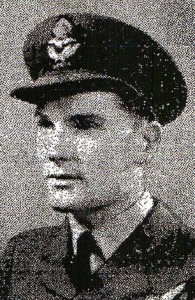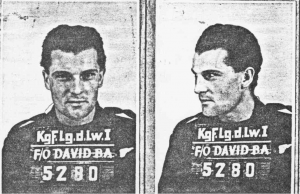Flying Officer J/26845 Bruce Arnold David RCAF
(Age 23 as of 13/08/44) D-O-B 9/8/21
Rear gunner, Lancaster LM658, bailed out, captured 13/08/1944.
Son of Mr Ambruise Louis David and Mrs Elizabeth Rose (Reuter nee Palko)
Step son of Mr Nicolas G Reuter
Brother of Flying Officer J/13085 John Martin David RCAF (KIA Oct 43)
Given address on enlistment: 41 Holly Ave North, Wentworth, Hamilton, Ontario, Canada.
 Bruce Arnold David was born in Prince Albert, Saskatchewan 9/8/21 and attended Arbury school in his hometown of Punnichy, then onto Muenster St Gertrudes RC school near Saskatoon, Saskatchewan. After leaving, he first worked as a farmhand in Punnichy then as a grocery store clerk and delivery driver for J.C. Thom in Saskatoon. His mother and father were estranged by this time. His mother Elizabeth was re-married to Nicolas G Reuter and living in Hamilton, Ontario. His Austrian born father, Ambruise Louis David, a Canadian army veteran of WW1 was now living in Cowichan Bay, near to the city of Duncan, Vancouver Island in British Columbia, working as a Lumberman for the Cowichan Merchants Company. In certain documents he is named as Ambruise LEO David, possibly an AKA.
Bruce Arnold David was born in Prince Albert, Saskatchewan 9/8/21 and attended Arbury school in his hometown of Punnichy, then onto Muenster St Gertrudes RC school near Saskatoon, Saskatchewan. After leaving, he first worked as a farmhand in Punnichy then as a grocery store clerk and delivery driver for J.C. Thom in Saskatoon. His mother and father were estranged by this time. His mother Elizabeth was re-married to Nicolas G Reuter and living in Hamilton, Ontario. His Austrian born father, Ambruise Louis David, a Canadian army veteran of WW1 was now living in Cowichan Bay, near to the city of Duncan, Vancouver Island in British Columbia, working as a Lumberman for the Cowichan Merchants Company. In certain documents he is named as Ambruise LEO David, possibly an AKA.
Bruce enlisted in the RCAF at the age of 19 in Saskatoon and was selected for air gunner training. He completed most of his training whilst still in Canada before being posted to the UK in June 1943 for attachment to the RAF. His brother Flying Officer John Martin David had already been in the UK since January 1943 and was operational with 7 (Pathfinder) Squadron on Lancasters as a mid-upper gunner. F/O John M David and crew were posted as missing on 19/10/43. When F/O Bruce David took off on his 29th op from Waltham in the rear turret of Lancaster LM 658 on the evening of 12/8/44 he was still unaware that his brother was already dead. It was to be only a few days later on 17/08/44 that Elizabeth Reuter received the news by telegram from the 100 Sqdn C/O, that her second son had also been posted as missing whilst on air operations over Europe.
We believe that Bruce David had been with the Paston-Williams crew for their full tour, as he was posted to 28 OTU at Wymeswold in the summer of 1943 and to 100 Squadron at Waltham on 8/5/44, the same time as Paston-Williams, Watts, and Williams. However there is no record of correspondence between his family and the other crew families who were in regular touch during the time when their respective fates were unknown.
From the statements of the surviving crew and from the information contained in his own P.O.W debrief documents we believe that after his last call to “corkscrew” Bruce David was cut off from the other crew members by the fire in the fuselage, the intercom system was out of action and he was left with the stark choice of jump or burn, so on his own initiative he made his escape either via the rear hatch or directly from his turret by rotating it through 90 degrees and rolling out. We know he landed further to the east than the other survivors, the flight engineer reported he could clearly see two other parachute canopies which were most likely the navigator Hood and the skipper Paston-Williams. Local Dutch resistance reports state that one of their patrols made contact with a downed airman, but unsure as to whom he could trust the airman made his escape. It was at first thought to be Flt/Sgt Laurie Watts the wireless operator, but some days later Laurie Watts was found dead under the wreckage so it was assumed this contact had been with Bruce David, who was soon picked up by an enemy patrol in the Dutch-German border region and became a prisoner of war.
Information passed via the Dutch underground to “Bill” Paston-Williams during his evasion suggested that his rear gunner Bruce had been injured in the shoulder during an exchange of fire with the German patrol that picked him up close to the Dutch/German border, but no evidence of this has subsequently emerged, although German POW documents do appear to indicate some injury to his left hand, not mentioned in his service documents.
He was first taken to the Dulag Luft aircrew processing centre near Frankfurt, where during interrogation he refused to give any details of his unit, crew or mission. From Frankfurt he was transferred North to Stalag Luft 1 at Barth on the Baltic coast to the north east of Rostock, arriving on 6/9/44 as POW 5280. It was the 13/9/44 before Bruce’s mother and father separately received word that their son was confirmed safe and a POW. He remained a prisoner at Stalag Luft 1 Barth until liberation in early May 1945, by a unit of Russian Cossacks. Barth had a reputation of a well ordered POW Camp with generally good morale, towards the end of the war it consisted of 80% USAF and 20% British and Commonwealth airmen. According to his MI9 debriefing form, escape attempts were forbidden by the Senior British Officer, Group Captain Cecil T “Ginger” Weir and from his own debriefing statement, during his time in captivity he was not mistreated or forced to work, he witnessed no instances of collaboration with the enemy and received good medical treatment as outlined in the Geneva Convention.
The liberation of Stalag Luft 1 at Barth is a story in itself, but what we do know is that F/O David was initially debriefed by MI9 on 11/5/45, which must have taken place whilst he was still at Barth, because records show the evacuation only commenced on 12/5/45. Records show that RAF / RCAF personnel were flown by the US 8th Air Force to airfields in the UK. Bruce returned to England on 14/05/45, most likely to Ford Airfield, Hampshire and on to 3PRC Bournemouth for debriefing which took place between the 15th and 17th of April.
On 17/05/45 a telegram from the Air Ministry arrived at Castle Gardens, Dorking, home of Bill Paston-Williams informing him that his friend and crewman was indeed safely back in the UK. Bill had requested to be notified when his rear gunner was as such and it is believed the two met up in London before Bruce returned to Canada, an emotionally highly charged meeting for both men, no doubt.
On 20/05/45 Bruce David set off (most likely by sea, possibly via Southampton) to return to Canada, arriving 1/6/45 at the RCAF Lachine repatriation depot, near Montreal, Quebec (Now Montreal International airport). From here he was posted to 1KTS RCAF Trenton near Toronto on 11/6/45. Here, not far from his mother’s home Bruce remained in service until 12/9/45 when he was placed on the reserve list and released, his given address being 608 Ottawa St, Hamilton, Ontario. No doubt to the relief of his mother Elizabeth (Beth) Reuter who had at least got her older son back from the European war.
Bruce’s younger brother, known to the family as Jacky, had failed to return from a raid on Hannover and was posted as missing back in 1943, he had officially been listed as presumed killed in 1944, but it was 1949 before his death was officially confirmed to the family and his remains were finally located, identified and re-interred in the British cemetery near Hannover. On his return to Canada, Bruce seemed to want to put his service past behind him and settle down into civilian life again. Hamilton was then the centre of Ontario’s steel industry, the town being dominated by huge employers such the STELCO Corp. Here Bruce took a job in the steel industry, where he worked until his death in 1980. No record of any further attempt to make contact with his former squadron, his skipper Paston-Williams, or the families of his crew has been found, not even any involvement with RCAF veterans organisations is apparent, it seems that Bruce David put his European service and adventures firmly behind him, wholly understandable and not an uncommon reaction, coupled with the burden of the family coming to terms with the loss of his younger brother. However he did claim and receive the campaign medals to which he was entitled, as follows; 1939-45 Star, France and Germany Star, Defence Medal, CVSM plus clasp, 1939-45 War Medal.
Extracts from correspondence between Mrs Reuter and government departments during efforts to confirm the death and whereabouts of her youngest son indicate the obvious pride in both her sons and a forgiveness of the combatants they faced, but a profound hatred of those who caused them to be there in Europe to face death in the name of freedom, proud, noble and powerful feelings from a woman who lost one son to the war and indeed almost lost both of them.
(Note, there is an element of doubt in the following paragraph, clarification from family members would be most welcome and updated accordingly);
In the mid 1950’s Bruce married Cassy, who had been a Private in the CWAC, they were together until 1974 when local electoral rolls show them living apart. Records show Cassy R David died in 1990 aged 66 and rests in Woodland Cemetery, Flamborough East, Ontario. Bruce David passed away in 1980, aged just 59 and lies in Eastlawn Cemetery, Hamilton Ontario. Information received points to the possibility that Bruce remarried for a second time but this is as yet unconfirmed.
In a curious end to the story, sometime in the early 1980’s a box was left at the offices of the Royal Canadian legion in Dunnville, Ontario containing the medals/ flying logs etc of Bruce Arnold David and John Martin David, also the medals of their father Ambruise Louis David, who served as a Canadian infantryman in the first world war, along with a note asking for these family relics to be looked after and displayed in the legion archives. The note was left anonymously and this was well after the deaths of Mrs Reuter (around 1970 after heart surgery), her second husband and both of the David brothers. Only the estranged Cassy was still alive in 1981. There is no evidence that Bruce and Cassy had a family so was she the donor of these family heirlooms and records of gallantry, or did Bruce marry for a second time? We will probably never know as Cassy passed away in 1990, but someone took the time to ensure they went to a fitting home, where they are displayed to this day… Here, the trail ends.
Alan (author, Lancaster LM658 Story).
